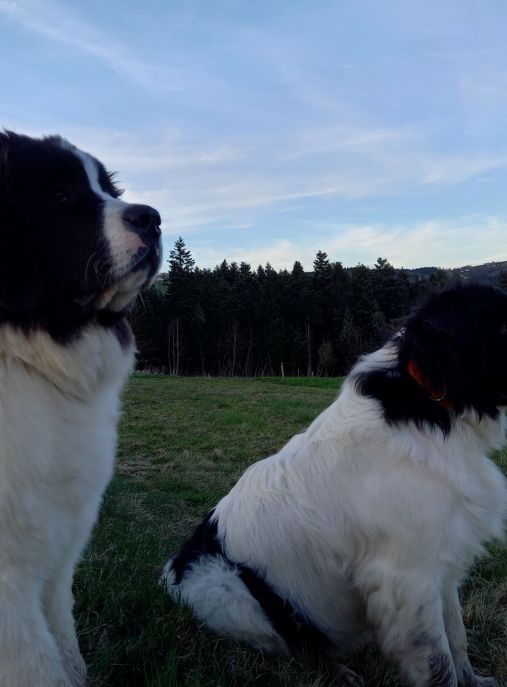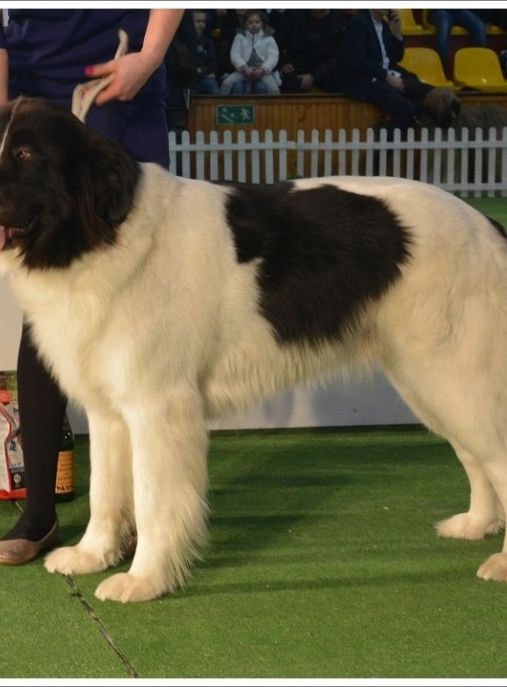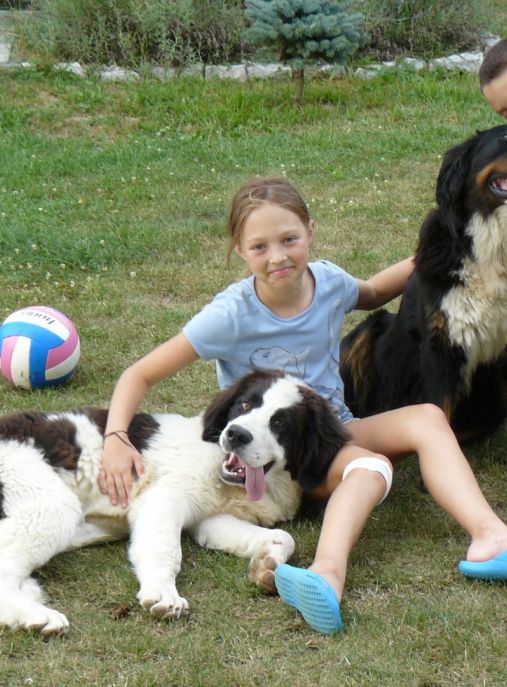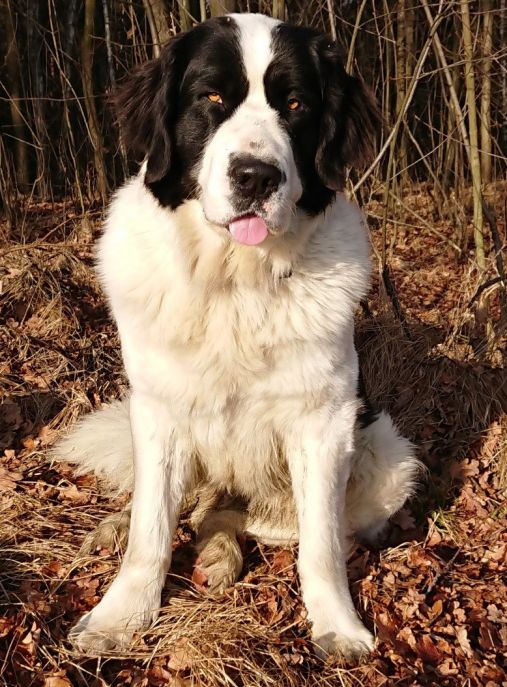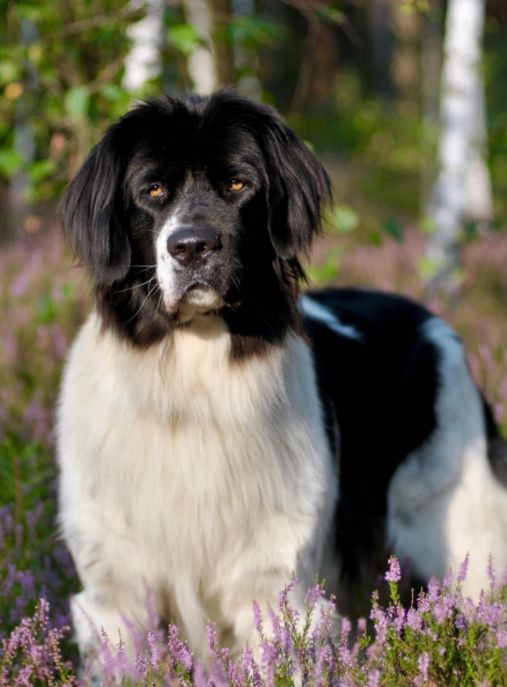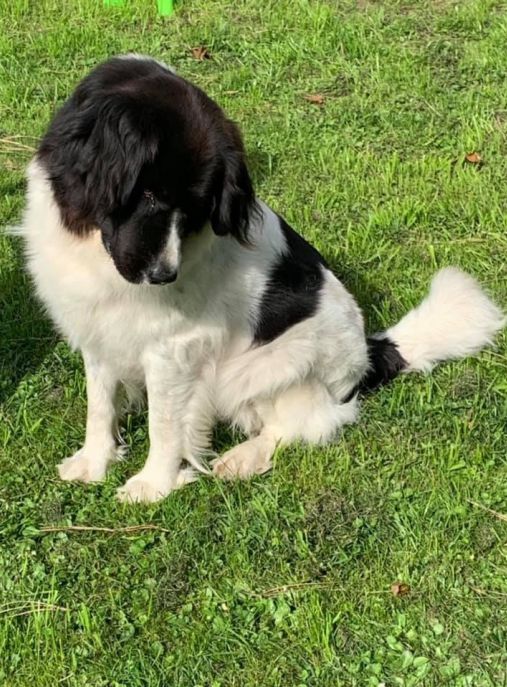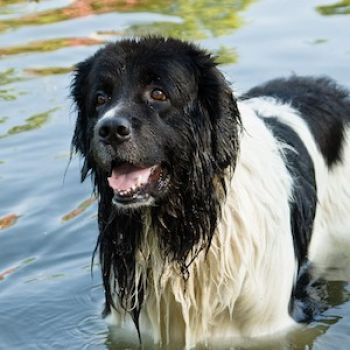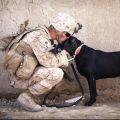The Landseer (European Continental Type) is a majestic and striking dog breed that is known for its large size, gentle nature, and distinctive black and white coat. This breed belongs to the Working Group according to the FCI (Fédération Cynologique Internationale) typology and is highly regarded for its strength, intelligence, and versatility. Landseers are often referred to as "gentle giants" due to their calm and friendly demeanor, making them excellent family pets and companions.
The history of the Landseer breed can be traced back to the 19th century in Europe, particularly in Germany and Switzerland. The breed was named after the famous British painter Sir Edwin Landseer, who often depicted these dogs in his artwork. Landseers are believed to have descended from the Newfoundland breed, which were brought to Europe by fishermen and sailors. Over time, breeders selectively bred these dogs to enhance their physical and temperamental traits, resulting in the development of the Landseer breed.
As mentioned earlier, the Landseer belongs to the Working Group according to the FCI typology. This group consists of breeds that were originally bred for various tasks such as guarding, herding, and pulling sleds. Landseers were primarily used as water rescue dogs, owing to their exceptional swimming abilities and strong build. They were trained to rescue drowning victims and assist fishermen in their work. Today, Landseers continue to excel in water rescue and are also utilized in other working roles such as therapy dogs and search and rescue operations.
In terms of appearance, Landseers are large and powerful dogs with a well-muscled body. Males typically stand between 28 to 31 inches (71 to 80 cm) at the shoulder, while females are slightly smaller, ranging from 26 to 29 inches (66 to 74 cm). The breed has a broad head with a well-defined stop, and their eyes are medium-sized and expressive. One of the most distinctive features of the Landseer is its coat, which is predominantly white with black markings. The black coloration covers the head, ears, and a portion of the body, creating a striking contrast against the white fur.
Landseers have a dense double coat that provides excellent insulation and protection in cold weather. The outer coat is long, straight, and slightly wavy, while the undercoat is soft and thick. Regular grooming is necessary to maintain the coat's health and prevent matting. Despite their thick fur, Landseers are relatively low shedders, making them suitable for individuals with allergies.
In terms of temperament, Landseers are known for their gentle and friendly nature. They are highly sociable dogs that get along well with children and other pets. Landseers are often described as patient, loyal, and eager to please, making them excellent family pets. However, due to their large size, early socialization and obedience training are essential to ensure they grow up to be well-behaved and obedient dogs.
The Landseer breed has a life expectancy of around 9 to 11 years, which is relatively average for a large breed. However, proper nutrition, regular exercise, and routine veterinary care can contribute to a longer and healthier life. It is important to note that Landseers are prone to certain health issues, including hip and elbow dysplasia, heart problems, and bloat. Responsible breeders conduct health screenings and genetic testing to minimize the risk of these conditions.
Landseers are not suitable for apartment living due to their size and exercise requirements. They thrive in homes with spacious yards where they can roam and play freely. Daily exercise is crucial for this breed to prevent obesity and maintain their physical and mental well-being. Long walks, swimming sessions, and interactive playtime are all beneficial for Landseers.
In conclusion, the Landseer (European Continental Type) is a remarkable breed that combines strength, intelligence, and a gentle nature. With their striking black and white coat, they are sure to turn heads wherever they go. Whether as water rescue dogs, therapy companions, or loving family pets, Landseers excel in various roles. Their size and exercise needs require dedicated owners who can provide them with the care, training, and attention they deserve. If you are looking for a loyal and affectionate companion with a majestic presence, the Landseer might be the perfect breed for you.
The Landseer, a majestic breed of dog belonging to the European Continental Type, is known for its striking appearance and gentle nature. These dogs are characterized by their large size, strong build, and distinctive black and white coat markings. With their intelligent and loyal temperament, Landseers make excellent family pets and are highly regarded for their gentle and patient nature.
One of the most prominent traits of Landseer dogs is their calm and composed demeanor. They are known for their gentle and patient nature, making them great companions for children and other pets. Landseers are generally friendly and sociable, and they thrive on human companionship. They are known to be very affectionate and are often referred to as "gentle giants."
Despite their large size, Landseers are not overly energetic dogs. They are generally laid-back and enjoy a relaxed lifestyle. However, they still require regular exercise to maintain their physical and mental well-being. Daily walks, playtime, and occasional swimming sessions are ideal for keeping them healthy and happy. Landseers are also known for their love of water, and many enjoy swimming and retrieving objects from the water.
Training a Landseer requires patience, consistency, and positive reinforcement. These dogs are intelligent and eager to please, making them relatively easy to train. Early socialization is crucial to ensure they grow up to be well-rounded and well-behaved dogs. Exposing them to various people, animals, and environments from a young age will help them develop into confident and friendly adults.
Landseers are known for their strong bond with their families, and they can be protective when it comes to their loved ones. While they are generally friendly towards strangers, they may exhibit a protective instinct if they sense a threat. Early socialization and proper training can help them differentiate between genuine threats and harmless situations.
When it comes to grooming, Landseers have a thick double coat that requires regular maintenance. Weekly brushing is necessary to prevent matting and keep their coat healthy and clean. They are moderate shedders, with heavier shedding occurring during seasonal changes. Regular nail trimming, teeth brushing, and ear cleaning are also essential parts of their grooming routine.
In conclusion, Landseer dogs are known for their gentle and patient nature, making them excellent family pets. They are loyal, intelligent, and eager to please, which makes training them a rewarding experience. With proper socialization, exercise, and grooming, Landseers can thrive in various living environments and bring joy and companionship to their families.
The Landseer (European Continental Type) is a majestic and gentle giant, known for its striking black and white coat and friendly disposition. Caring for a Landseer requires a combination of love, attention, and specific care guidelines to ensure their well-being. Here are some tips on how to care for dogs of this breed, including what to do and what not to do:
1. Grooming: Landseers have a thick double coat that requires regular grooming to keep it healthy and free from mats. Brush their coat at least once a week using a slicker brush or a comb with wide teeth. Pay special attention to their feathering on the legs and tail. Regular brushing helps to prevent tangles and removes loose hair.
2. Bathing: Landseers are not excessive shedders, but they do require occasional baths to keep their coat clean and fresh. Use a mild dog shampoo and ensure thorough rinsing to avoid skin irritation. Avoid bathing them too frequently as it can strip their coat of natural oils.
3. Exercise: Landseers are active dogs that require regular exercise to keep them physically and mentally stimulated. Aim for at least 1-2 hours of exercise daily, which can include walks, jogs, swimming, or playing in a secure, spacious area. However, be cautious not to over-exercise them during hot weather as they are prone to heat exhaustion.
4. Training and Socialization: Early training and socialization are crucial for Landseers to develop into well-behaved and confident dogs. Enroll them in puppy classes and expose them to various environments, people, and other animals. Positive reinforcement techniques work best with this breed, as they respond well to praise and rewards.
5. Feeding: Provide a balanced and high-quality diet suitable for large breed dogs. Feed them twice a day to prevent bloating, a condition to which they are prone. Avoid overfeeding, as Landseers have a tendency to gain weight, which can put strain on their joints.
6. Health Care: Regular veterinary check-ups are essential to monitor the Landseer's overall health. Vaccinations, parasite prevention, and dental care should be maintained as per the veterinarian's recommendations. Additionally, Landseers are prone to certain health issues like hip dysplasia, heart conditions, and eye problems, so be vigilant and seek prompt veterinary attention if any concerns arise.
7. Environment: Landseers are not well-suited for apartment living due to their large size and exercise needs. They thrive in homes with access to a secure, fenced yard where they can roam and play freely. Ensure the yard is escape-proof, as Landseers may have a tendency to wander.
What not to do:
1. Do not leave your Landseer alone for extended periods. They are social dogs and thrive on human companionship. Leaving them alone for too long can lead to separation anxiety and destructive behavior.
2. Do not use harsh training methods or punishment. Landseers are sensitive dogs and respond best to positive reinforcement techniques. Harsh training methods can lead to fear or aggression.
3. Do not neglect their dental hygiene. Regularly brush their teeth and provide dental chews or toys to prevent dental issues, which are common in this breed.
4. Do not allow your Landseer to become overweight. Obesity can lead to various health problems, including joint issues. Monitor their weight and adjust their diet accordingly.
5. Do not expose your Landseer to extreme temperatures. They are more comfortable in cooler climates, so provide shade and fresh water during hot weather, and ensure they have a warm, sheltered area during cold weather.
Caring for a Landseer requires commitment, time, and effort, but the rewards of having this gentle giant as a companion are immeasurable. By following these care guidelines and providing them with love and attention, you can ensure a happy and healthy life for your Landseer.
The Landseer (European Continental Type) dog is known for its striking and distinctive coat color. These magnificent dogs possess a predominantly white coat with well-defined black markings. The coloration of Landseer dogs is a defining characteristic that sets them apart from other breeds.
The base color of a Landseer dog is a brilliant white, which covers the majority of their body. This white coat is often described as pure and pristine, giving these dogs an elegant and regal appearance. The white fur is usually dense and thick, providing insulation and protection against harsh weather conditions.
Contrasting with the white coat are the black markings that are present on various parts of the Landseer's body. These markings are well-defined and typically cover the head, ears, and a portion of the body. The black coloration adds depth and definition to the overall appearance of the dog.
The Landseer's head is adorned with a black mask, which extends from the nose to the eyes, giving them a distinctive and expressive look. The ears are also predominantly black, with the black coloration often extending down the sides of the neck. This black coloration on the head and ears creates a beautiful contrast against the white coat, highlighting the dog's facial features.
Moving down the body, Landseer dogs often have a black saddle-like marking on their back. This saddle-shaped patch starts at the withers and extends towards the tail. The black coloration on the back is usually well-defined and can vary in size and shape, adding a touch of uniqueness to each individual Landseer.
In addition to the black markings, Landseer dogs may also have small black spots or freckles scattered throughout their white coat. These spots are often seen on the legs, chest, and belly, adding a charming and playful element to their appearance.
The Landseer's coat color is not only visually appealing but also serves a practical purpose. The contrasting black markings help these dogs stand out in the water, making them more visible during rescue operations or when retrieving objects. This coloration is also believed to have evolved as a camouflage in their natural habitat, allowing them to blend in with their surroundings.
Overall, the color of Landseer (European Continental Type) dogs is a stunning combination of predominantly white fur with well-defined black markings. This unique coloration enhances their majestic and noble presence, making them a truly remarkable breed.
The Landseer (European Continental Type) dog is a majestic and beautiful breed known for its striking black and white coat and gentle temperament. When it comes to their health, Landseers are generally considered to be a robust and healthy breed. However, like all dogs, they are prone to certain health issues that owners should be aware of to ensure their well-being.
One of the most common health concerns in Landseers is hip dysplasia. This is a genetic condition where the hip joint doesn't develop properly, leading to pain, lameness, and arthritis. Regular exercise on soft surfaces, maintaining a healthy weight, and providing joint supplements can help manage this condition. It is also advisable to have Landseer puppies screened for hip dysplasia by a veterinarian before purchasing or adopting them.
Another common health issue in Landseers is heart disease, particularly subvalvular aortic stenosis (SAS). This is a congenital condition where the aortic valve narrows, restricting blood flow. Regular cardiac check-ups, including echocardiograms, are recommended to detect and manage this condition early on. Breeding dogs should also undergo cardiac evaluations to prevent passing on this genetic condition to future generations.
Landseers are also prone to certain eye problems, including entropion and ectropion. Entropion is a condition where the eyelid rolls inward, causing irritation and potential damage to the cornea. Ectropion, on the other hand, is when the eyelid droops outward, leaving the eye exposed and prone to infections. Regular eye examinations and prompt treatment, including surgical correction if necessary, can help prevent complications and discomfort.
Additionally, Landseers may be susceptible to gastric dilatation-volvulus (GDV), commonly known as bloat. This is a life-threatening condition where the stomach fills with gas and twists on itself. Feeding multiple small meals throughout the day, avoiding exercise immediately after meals, and using elevated feeding bowls can help reduce the risk of bloat. If you notice symptoms such as restlessness, unproductive retching, or a distended abdomen, seek immediate veterinary attention.
To ensure the overall health and well-being of Landseers, it is essential to provide them with a balanced diet that meets their nutritional needs. Regular exercise is crucial to maintain their weight and keep their joints healthy. Mental stimulation through training, interactive toys, and socialization is also important to prevent boredom and behavioral issues.
Regular veterinary check-ups are vital for early detection and prevention of any potential health problems. Vaccinations, parasite prevention, dental care, and grooming should also be part of their routine care.
In conclusion, Landseers are generally healthy dogs, but they are prone to certain genetic conditions and health issues. Responsible breeding practices, regular veterinary care, a balanced diet, and appropriate exercise and mental stimulation are key to ensuring the health and happiness of Landseer (European Continental Type) dogs.
The Landseer (European Continental Type) dog is a majestic and beautiful breed known for its gentle nature and striking appearance. When it comes to their nutrition, it is essential to provide them with a well-balanced diet that meets their specific needs. This breed requires a combination of high-quality protein, healthy fats, carbohydrates, vitamins, and minerals to maintain optimal health and vitality.
Protein is a crucial component of a Landseer's diet as it supports muscle development and repair. Look for dog food that contains high-quality animal-based proteins like chicken, beef, fish, or lamb. It is important to ensure that the protein source is the primary ingredient listed on the dog food label.
Healthy fats are another essential nutrient for Landseer dogs. Fats provide energy, support the absorption of fat-soluble vitamins, and contribute to a shiny coat and healthy skin. Look for dog food that includes sources of healthy fats such as fish oil, flaxseed, or chicken fat.
Carbohydrates are an important energy source for dogs, but it is crucial to choose complex carbohydrates that provide sustained energy rather than simple sugars. Whole grains like brown rice, oats, and barley are excellent choices. Avoid dog foods that contain excessive amounts of fillers like corn, wheat, and soy, as these can cause allergies or digestive issues in some dogs.
Vitamins and minerals play a vital role in a Landseer's overall health. Look for dog food that includes a wide range of fruits and vegetables, as these provide essential vitamins and minerals. Some beneficial options include sweet potatoes, carrots, blueberries, and spinach. If you choose to feed your Landseer a homemade diet, it is important to consult with a veterinarian or canine nutritionist to ensure all nutritional requirements are met.
When it comes to feeding Landseer dogs, it is recommended to divide their daily food intake into two meals to prevent bloating and aid digestion. The exact amount of food required will depend on factors such as age, weight, activity level, and metabolism. It is important to monitor their weight and adjust the portion sizes accordingly to prevent obesity or malnutrition.
In addition to a balanced diet, fresh water should always be available for your Landseer. Hydration is crucial for their overall health and well-being.
While it is important to focus on what to include in a Landseer's diet, it is equally important to be aware of what to avoid. Certain foods can be toxic or harmful to dogs, including chocolate, grapes, raisins, onions, garlic, and artificial sweeteners like xylitol. Additionally, avoid feeding your Landseer table scraps or excessive treats, as this can lead to weight gain and nutritional imbalances.
Regular exercise is also essential for Landseer dogs to maintain a healthy weight and overall well-being. Daily walks, playtime, and mental stimulation are crucial for their physical and mental health.
In conclusion, providing a Landseer (European Continental Type) dog with a well-balanced diet that includes high-quality protein, healthy fats, complex carbohydrates, and a variety of fruits and vegetables is essential for their overall health and vitality. Remember to consult with a veterinarian or canine nutritionist to ensure you are meeting their specific nutritional needs. By providing proper nutrition and regular exercise, you can help your Landseer live a long, healthy, and happy life.

